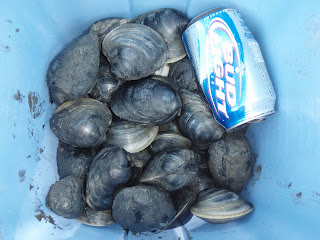
Have you ever been clamming?
I have and I love it.
I have been going clamming since I was about 5, when I thought that the tiny snail shells everywhere were tiny, dainty horse poops (Chincoteague ponies, perhaps) left by early Native Americans and original colonists who had magically survived into the 20th century and were riding these horse-ponies across the marsh. Perhaps it was because the marsh was so quiet and seemed so mysterious to me.
Back then, my job was to follow my dad for up to half a mile across the mud and through the knee to waist-deep water and then dig where I was told. That is actually more or less still my job, except now I carry a bucket and my own rake. I thought I'd make a little photo-documentary of the recent clamming trip I took with my dad. Maybe those of you who have never clammed will develop a taste for it and the confidence to go to it. Maybe those of you who have clammed before will decide that I am a more ridiculous person than you thought because who would do this year after year for "fun?" Or maybe you won't. Maybe you like clams, maybe you don't. It's not my job to tell you what to eat or how to get your food. Except that I'm going to here.
ONTO THE CLAMMING.
When you go clamming, you go to a place that looks like this:

A marsh. We go to a place called "The Point" at the end of Oak Island, NC, where the beach and the intracoastal waterway meet. The water is very calm and you go at low tide. You walk across the water to find some undiscovered area (or, at least where the clams are undiscovered.)
Here is a picture of my dad bravely crossing the perfectly calm waist-deep water. (You actually do have to be a little brave; there are all kinds of creatures in that water! But they're harmless. It depends on how phobic you are.)

(You will see that my dad is headed back toward civilization, the beach houses. This photo is actually from the way back. I just wanted to put in one of somebody crossing the water.)
So this is what it looks like to clam.


And this is what it looks like when you find a clam!

What happens is that you dig, dig, dig, not very deep, but you try to cover a large area. And then you hear a faint scraping sound and you feel it in your rake. You dig a little more and you strike something, you feel the weight of the clam as you pry it from the mud with your rake, and then, ta da! clam.
This time, we found a lot of clams within a very short period of time; 3 or 4 dozen in 45 minutes, I'd say. But, there is a price to pay for all this free food. Your shoes get very dirty.

Here's a picture of our bounty.

And here's our bounty partying.

And here's a member of our bounty partying with a crab claw.

From a fancy homemade (and homecaught) paella.

1 comment:
* The clammer pictured, H.T. Kirby-Smith, is also a writer and poet. His books include The Origins of Free Verse (University of Michigan Press, 1996), A Philosophical Novelist: George Santayana and The Last Puritan (Southern Illinois University Press,1997), The Celestial Twins: Poetry and Music Through the Ages (University of Massachusetts Press, 1999,
The Musical Constellations (Unicorn Press, 2007) and U.S. Observatories: A Directory and Travel Guide. His tutorial on poetry and meter can be found at http://www.uncg.edu/~htkirbys/intro.html
Post a Comment